Growing a Dragon Fruit Cactus can be an enriching and rewarding experience, whether you’re a seasoned gardener or just starting to explore the world of exotic plants.
These fascinating cacti, known for their striking appearance and delicious fruit, are more than just a pretty face in your garden.
Let’s delve into the world of Dragon Fruit Cacti and uncover the joys and benefits of nurturing these unique plants.
Benefits of Growing a Dragon Fruit Cactus
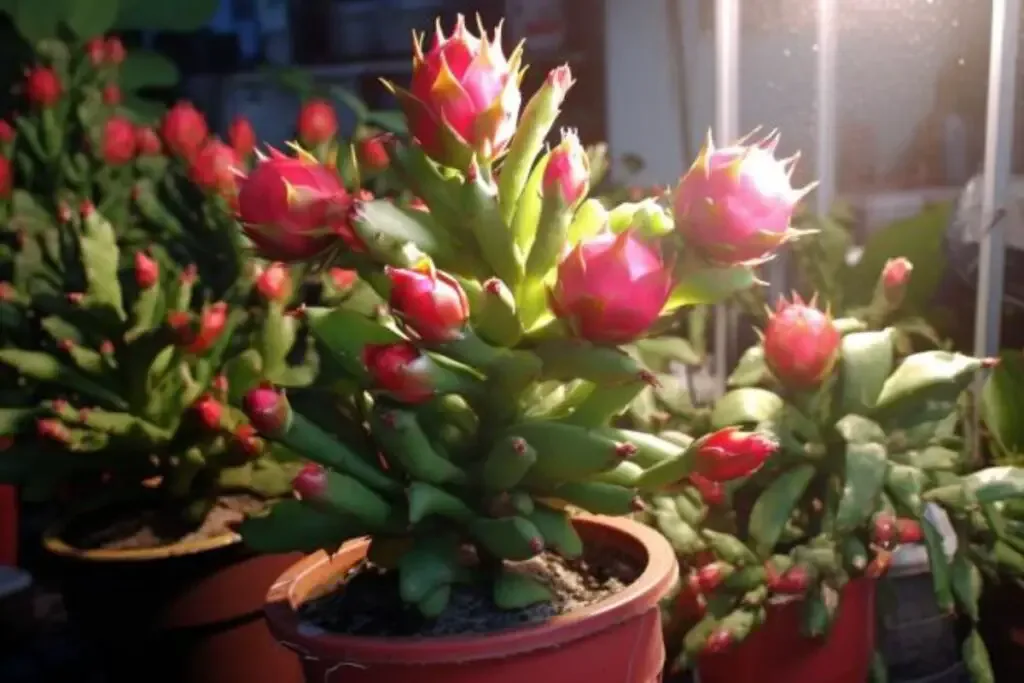
1. Nutritional Powerhouse
One of the most compelling reasons to grow Dragon Fruit Cactus is its fruit’s nutritional value.
Packed with antioxidants, vitamins, and fiber, dragon fruit is not only a tasty treat but also a health booster.
Incorporating it into your diet can aid in digestion, boost the immune system, and even help in maintaining healthy blood sugar levels.
2. Aesthetic Appeal
Beyond its health benefits, the Dragon Fruit Cactus is a stunning addition to any garden.
Its unique appearance, with vibrant flowers and an architectural structure, makes it a focal point in landscape design.
Whether in bloom or not, this plant is sure to turn heads and spark conversations among your visitors.
3. Low Maintenance
For those worried about the complexities of gardening, fear not! Dragon Fruit Cactus is surprisingly low maintenance.
It thrives in well-drained soil and requires minimal watering, making it a perfect choice for busy gardeners or those living in dry climates.
This resilience makes it an excellent choice for both beginners and experienced gardeners alike.
My Favorite Dragon Fruit Varieties
When it comes to selecting Dragon Fruit Cactus for your garden, variety is key. Each type brings its own unique flavor and appearance, offering something special to the grower.
Here are my top picks that not only look great but also taste amazing.
1. Hylocereus undatus
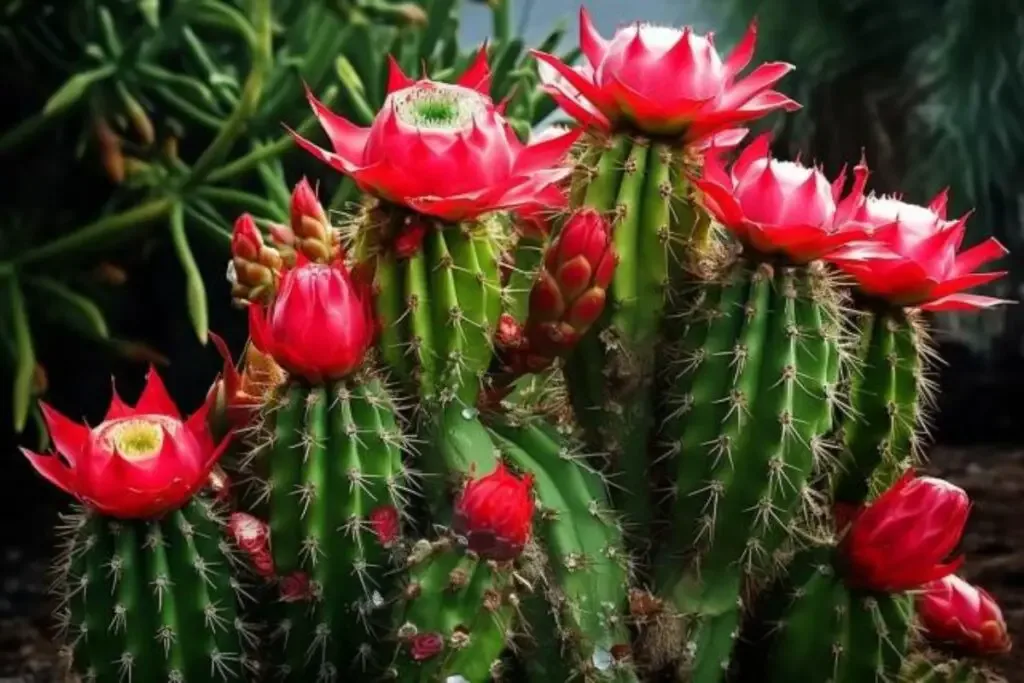
This variety, often just called white dragon fruit, is the most common and perhaps the easiest to start with.
Known for its white flesh and sweet, mild flavor, it’s a go-to for those new to dragon fruit cultivation. Its resilience and relatively fast growth make it a rewarding choice for beginners.
2. Hylocereus costaricensis
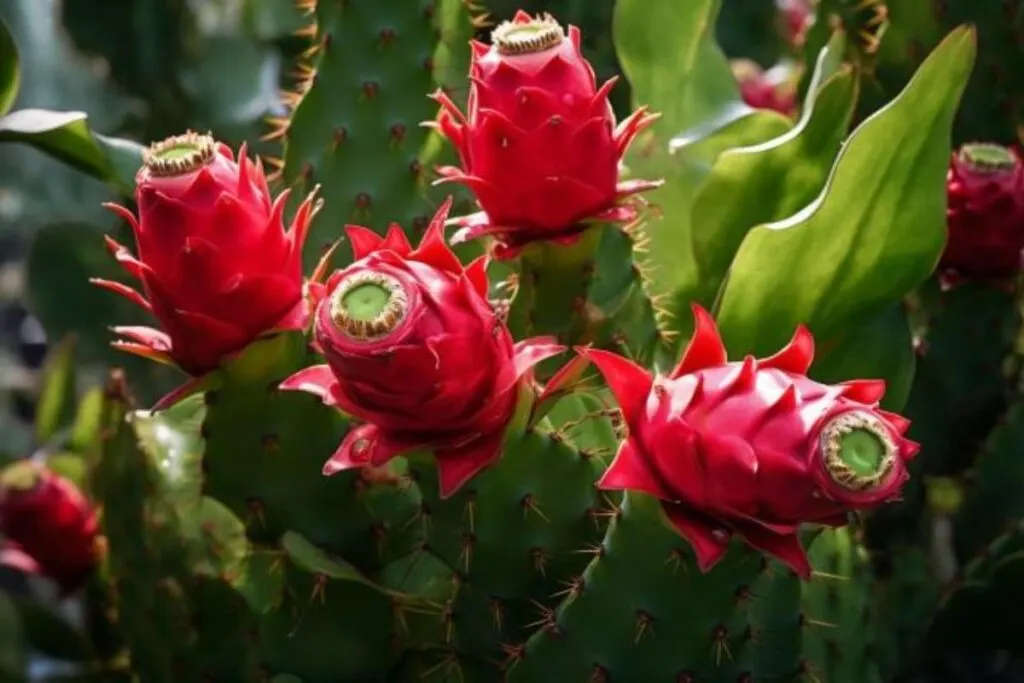
For those looking to add a pop of color, the Hylocereus costaricensis, with its vibrant red flesh, is a striking choice.
The fruit from this variety is not only visually stunning but also has a slightly tangier taste compared to the white variety. It’s a favorite among dragon fruit enthusiasts for its bold flavor profile.
3. Hylocereus megalanthus
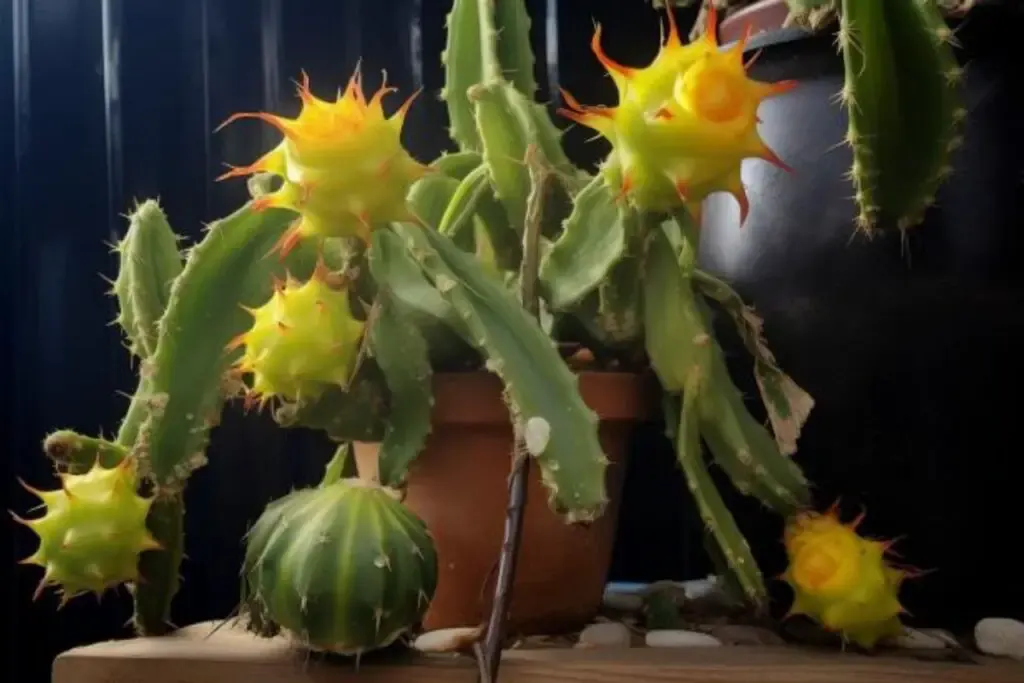
The Hylocereus megalanthus, or yellow dragon fruit, is a rarer variety that’s highly sought after for its unique taste and appearance.
Its yellow skin and white flesh dotted with black seeds make it a visually appealing addition to any garden.
The fruit is sweeter and crunchier compared to other varieties, making it a special treat for those who can find it.
Dragon Fruit Care
Caring for a Dragon Fruit Cactus is a gratifying process that brings together various elements of gardening. Understanding the specific needs of this plant will ensure a bountiful and healthy growth.
Let’s dive into the essential aspects of caring for your Dragon Fruit Cactus.
Planting
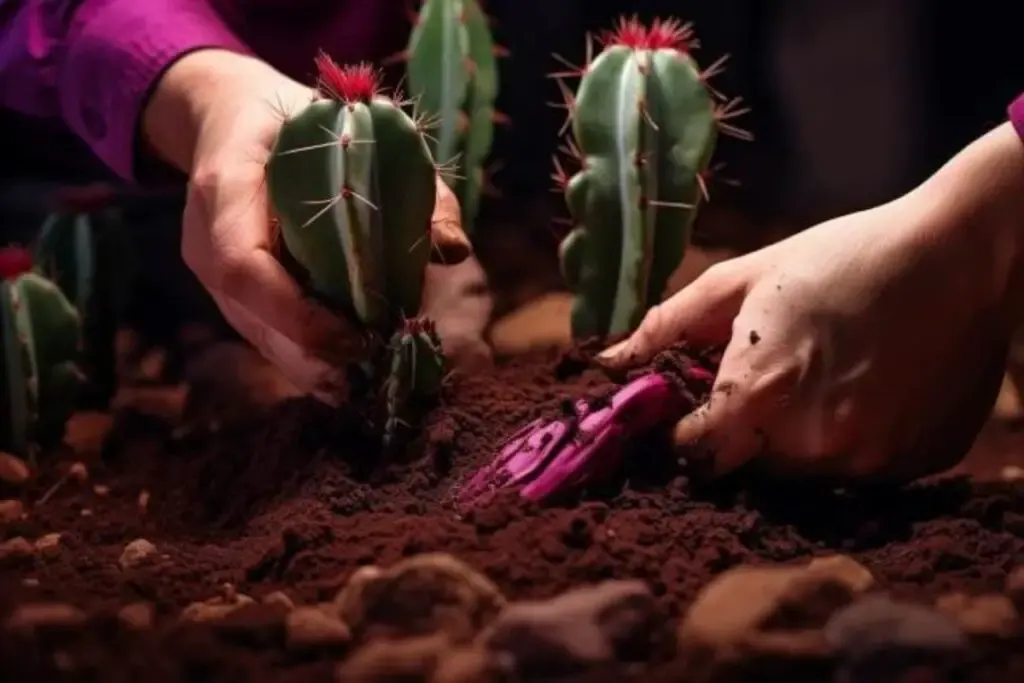
When planting your Dragon Fruit Cactus, choose a location that provides ample space for growth. These cacti can grow quite large and require support structures like trellises or stakes as they mature.
Plant them in a spot where they can spread out and climb. Spring is the ideal time for planting, allowing the plant to establish itself during the warmer months.
Light
Dragon Fruit Cacti love sunlight. They thrive in full sun exposure, requiring at least six hours of direct sunlight daily.
If you’re growing them indoors, place them near a window where they’ll receive ample light. In extremely hot climates, however, some afternoon shade can be beneficial to prevent scorching.
Soil
Well-drained soil is crucial for Dragon Fruit Cacti. They prefer a sandy or loamy soil mix that allows for good drainage.
Poor drainage can lead to root rot, so ensure your planting site or pot doesn’t hold water. You can improve drainage by adding sand or perlite to your soil mix.
Water
While Dragon Fruit Cacti are drought-tolerant, they do require regular watering for optimal growth, especially during the growing season.
Water the plant when the top inch of the soil is dry, usually every week or so. In winter, reduce watering to prevent overwatering, which can harm the plant.
Temperature and Humidity
Dragon Fruit Cacti prefer warm and somewhat humid conditions. They thrive in temperatures between 65-85°F (18-29°C). They can tolerate higher humidity levels but do well in drier conditions too.
However, they are not frost-tolerant and should be protected or brought indoors in regions where temperatures drop significantly.
Fertilizer
Fertilizing your Dragon Fruit Cactus can boost its growth and fruit production. Use a balanced, slow-release fertilizer during the growing season, typically in the spring and summer.
Avoid over-fertilizing, as this can lead to more foliage growth at the expense of fruit production. A light application of a well-balanced fertilizer every couple of months is sufficient.
Harvesting Dragon Fruit
Harvesting Dragon Fruit is an exciting part of the growing process, signaling the culmination of your hard work and care.
The key to a successful harvest is timing. Dragon Fruit typically ripens about 30 to 50 days after flowering. Look for vibrant coloration in the fruit; when they change from green to red or yellow, depending on the variety, they are ready to harvest.
The fruit should be slightly soft to the touch. To harvest, simply cut the fruit from the cactus with a sharp knife or scissors, leaving a small piece of the stem attached.
Pruning
Pruning is an essential aspect of Dragon Fruit care. It helps maintain the plant’s size, encourages more fruit production, and removes any dead or diseased parts.
Prune your Dragon Fruit Cactus in the late winter or early spring before new growth begins. Focus on cutting away any dead or overly crowded stems to improve air circulation and sunlight exposure to the plant.
Always use clean, sharp pruning tools to make precise cuts and avoid damaging the plant.
Propagating
Propagating Dragon Fruit Cactus is a straightforward and rewarding process. The most common method is using stem cuttings.
Select a healthy, mature stem and cut a 6-12 inch segment. Allow the cutting to dry for about a week until a callus forms over the cut area.
Plant the cutting in a well-draining soil mix, keeping it lightly moist until it establishes roots, which usually takes a few weeks.
This method is simple and effective, making it easy to expand your Dragon Fruit collection or share it with fellow gardeners.
How to Grow Dragon Fruit From Seed
Growing Dragon Fruit from seed can be a longer, but equally rewarding process. To start, extract seeds from a ripe Dragon Fruit and rinse them to remove any pulp.
Plant the seeds in a well-draining soil mix, lightly covering them with soil. Keep the soil consistently moist and in a warm, bright location.
Germination can take anywhere from a few weeks to a couple of months. Patience is key! Seedlings can be transplanted to larger pots or a permanent location once they’re a few inches tall.
Growing in Pots
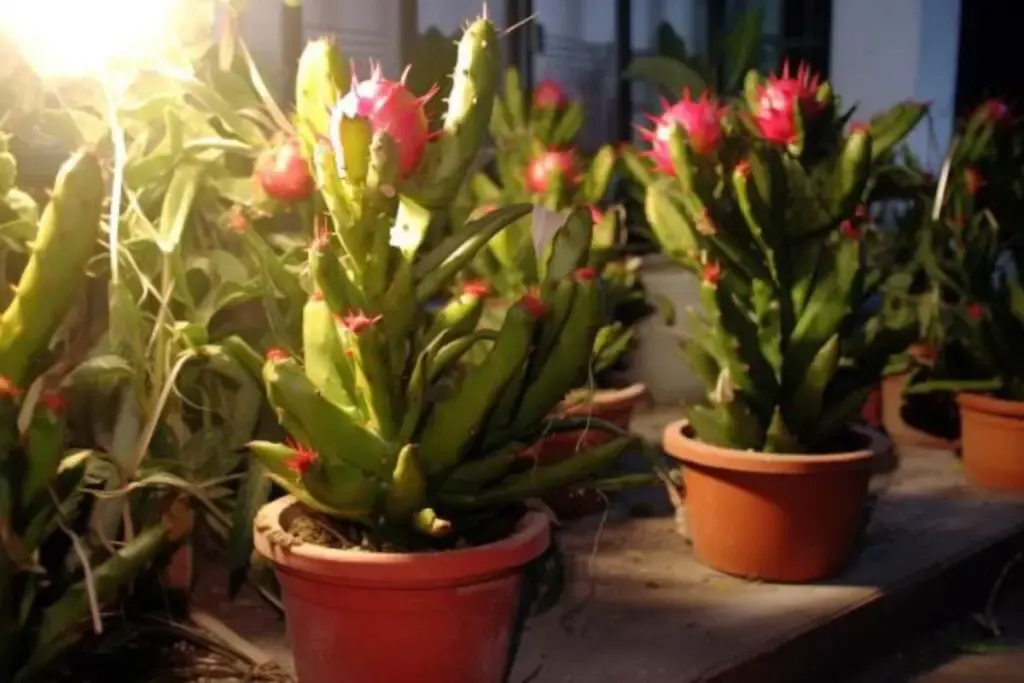
Growing Dragon Fruit in pots is an excellent option for those with limited space or unsuitable soil conditions. Choose a large pot with adequate drainage holes to accommodate the plant’s growth.
Use a well-draining soil mix and place the pot in a sunny location. Potted Dragon Fruit Cacti require more frequent watering than those in the ground, as pots tend to dry out quickly.
Also, be prepared to provide support structures like stakes or trellises as the plant grows. With proper care, even potted Dragon Fruit can produce abundant and delicious fruits.
Overwintering
Overwintering your Dragon Fruit Cactus is crucial, especially in areas where temperatures drop below 32°F (0°C). These plants are not frost-tolerant, so it’s essential to protect them from the cold.
If grown in pots, move them indoors to a well-lit area where temperatures remain consistent. For outdoor plants, cover them with frost cloths or move them to a greenhouse.
Reduce watering significantly during the winter months, as the plant enters a dormant phase and requires less moisture.
Transplanting
Transplanting a Dragon Fruit Cactus can be necessary as it outgrows its current space. The best time to transplant is in the spring, just before the active growth period.
When transplanting, handle the roots gently to minimize stress and damage. Choose a new location or pot that offers ample space, adequate sunlight, and well-draining soil.
After transplanting, water the plant thoroughly to help settle the soil around the roots and reduce transplant shock.
Common Pests & Diseases
Like any plant, Dragon Fruit Cacti can face challenges from pests and diseases. Common pests include aphids, mealybugs, and scale insects, which can be controlled with neem oil or insecticidal soap.
As for diseases, root rot is a primary concern, often caused by overwatering or poor drainage. Ensure good soil drainage and follow a proper watering schedule to prevent this issue.
Regularly inspect your plants for signs of trouble and address any issues promptly to keep your Dragon Fruit healthy and thriving.
In the end, growing and caring for a Dragon Fruit Cactus is a journey filled with learning, joy, and, of course, delicious fruits.
These exotic plants not only bring beauty and interest to your garden but also the satisfaction of nurturing something truly unique.
With the right care and attention, your Dragon Fruit Cactus will be a splendid addition to your garden, offering both aesthetic and culinary delights.
Happy gardening!
